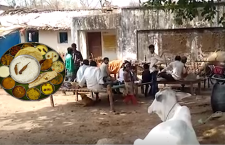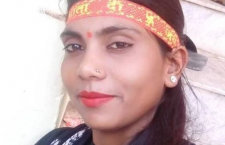 Up-close with Banda members of the “socio-cultural” organization founded by the now-sitting Chief Minister of Uttar Pradesh, in a special five-part series for VICE India. It’s the closest you’ll get to the sangathan that lies low only to get even more active.
Up-close with Banda members of the “socio-cultural” organization founded by the now-sitting Chief Minister of Uttar Pradesh, in a special five-part series for VICE India. It’s the closest you’ll get to the sangathan that lies low only to get even more active.
In December 2017, after months of playing cat-and-mouse with members of the Hindu Yuva Vahini, I got a message on a WhatsApp group about a gathering on “Shaurya Diwas”, the anniversary of the demolition of the Babri Masjid. Posters advertising the December 6 event were plastered around Banda, in the Bundelkhand region of southern Uttar Pradesh. These Photoshopped works of art depicted a muscular Rama, flanked by a punier local leader, against the background of the Ram Mandir compound, wreathed in red smoke.
The images gave me goosebumps. Despite my trepidation, I arrived, camera in hand, at the HYV’s Banda office: a large compound with a few motorbikes and cows, a shed, and a temple where meetings are generally held, if not under the shade of a peepal tree outside. It didn’t look much like the regional nerve center of a powerful youth militia with political patronage, whose founder Yogi Adityanath was now chief minister of the state.
Inside the temple, I sat outside a circle of 10 men—11 if you count the swarthy figure of Hanuman presiding over us. My presence was charged: a woman and a reporter? The men were suspicious, but soon warmed up. They vowed—as other Hindu organisations had done—to mark Shaurya Diwas yearly until the Ram Mandir was built. They even let me film a series of video portraits in which they explained what Ayodhya meant to them. An older advisor, Adhirsh Singh, talked about the historical “proof” that the three acres of disputed land were passed down by King Dashrath. For him, these were not “Hindu truths”, but geographical ones. Dinesh Kumar, “Dadda”, the district coordinator, put forward his opinion that Babar should be seen in a long line of “Muslim terrorists.”
Despite the enthusiasm, the event felt somewhat anticlimactic, especially when compared to the beginning of that year, when the HYV was on a high. In March, it had helped the Bharatiya Janata Party capture the Legislative Assembly and ensured for Adityanath the foremost seat.
Adityanath founded the HYV in 2002, but it was only around Ram Navami 2017, soon after the new government came to power, that I suddenly saw members of Yogi’s youth wing everywhere in Bundelkhand: managing crowds and traffic, playing at bouncer, priest, and police. The organisation was reportedly swelling, especially outside its traditional stronghold of eastern UP.
Who were these men, and how deep was their loyalty to Adityanath’s organisation? Were they as efficient and influential as they appeared in the news, and in their processions? Or was the HYV just the latest banner being hoisted by vigilantes and criminals to gain legitimacy?
Over the next few months, I did everything to find out, short of signing up myself— something I couldn’t bring myself to do, though several colleagues and members suggested I should try. As a woman with less than conducive caste and political credentials, I felt ambiguous about actually joining this male, Hindu bastion, dominated by Thakurs and other “upper castes”. Still, each time I approached what was touted as one of the most powerful forces in UP, the HYV seemed to vanish, like the mirage of a shiny glass building on a hot, dusty road.
A little over a year after Adityanath’s victory, it seems obvious that the HYV was on shaky ground. The army that had propelled its mukhya to power was a threat to the BJP and its affiliates in the Sangh Parivar. As the HYV saw mass desertions, there was also reportedly a growing dissonance between its higher echelons and its newer foot-soldiers. Consequentially, the BJP’s defeat in Gorakhpur and Phulpur in the March 2018 bypolls was seen by many as a turning of the tide.
Looking back over my nine months of befriending HYV members, and eavesdropping on their real life and WhatsApp conversations to try and get access to the group, this wasn’t too surprising. I had found that for its newest, youngest, grassroots members, loyalty to the Hindu militia was born not only—or not even primarily—out of a sense of religious duty. Their motivations were in keeping with those of any millennial with few prospects, with an eye out for a step up, or out. Some came to the HYV out of personal need or a sense of responsibility to community. Others were drawn to the outfit by family or caste connections. These factors often blurred with political ambition.
On December 10, a few days after Shaurya Diwas, I finally found myself inside an HYV meeting in Banda. There were even fewer people present, and the mood of these men in their 20s and 30s was mostly disgruntled. A notice had been circulated, suspending members who had contested in the UP civic polls the previous month, even though they had allegedly been granted permission to contest earlier.
The promise of BJP electoral tickets, or implicit blessings for candidates’ campaigns, were crucial in mobilising HYV support in the Assembly elections that year. Perhaps more so than the selfless urge to do social work or religious fervour. But when the members started to remind the organisational leadership of this promise of political power, it became clear that they had been “doing all that work”, as one member said, “for nothing.”
In a sense, the following profiles of one woman and three men of the Hindu Yuva Vahini illustrate the fragility of such networks and their symbiotic relationship with electoral politics. But through each story also runs the strong current of the HYV’s religious discourse, threatening to consume those who dip their toes in the waters of Hindutva.
Reporting by Meera Devi & Kavita Devi.
Writing by Disha Mullick & Pooja Pande.
This five-part series originally appeared on VICE India.

